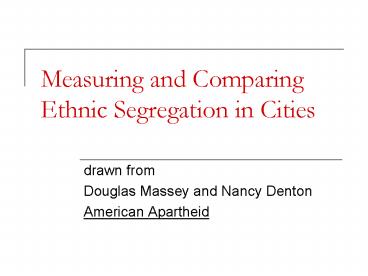Measuring and Comparing Ethnic Segregation in Cities - PowerPoint PPT Presentation
1 / 9
Title:
Measuring and Comparing Ethnic Segregation in Cities
Description:
American Apartheid. Indices. Index of segregation. Calculate the percentage of A population that would have to move in order to ... – PowerPoint PPT presentation
Number of Views:138
Avg rating:3.0/5.0
Title: Measuring and Comparing Ethnic Segregation in Cities
1
Measuring and Comparing Ethnic Segregation in
Cities
- drawn from
- Douglas Massey and Nancy Denton
- American Apartheid
2
Indices
- Index of segregation
- Calculate the percentage of A population that
would have to move in order to even out the ratio
of A to B among all the districts - Index of isolation
- Calculate the ratio of A to B that is experienced
in the surrounding district by every member of A,
then calculate the average
3
Index of Segregation (of reds)
0
40
2/5
0
80
8/10
4
Index of Isolation (of reds)
33
49.2
(3x60)(2x33.33) / 5
50
83.7
(8x100)(1x20)(1x16.7) / 10
5
Notes on indices
- Both vary from 0 to 100
- Both are generally above 60 when cities are
fairly strongly segregated - Index of segregation is high if there is
segregation, regardless of the absolute number of
people in a minority population - Index of isolation may be low when a minority is
very small, even if it is strongly segregated - Index of segregation is the best means of
comparing between populations and cities - Index of isolation is more reflective of the
experience of the racial isolation/mixture in
cities
6
History of segregation in the US1
- Was ethnic segregation in American cities
stronger or weaker at the start of the 20th c.? - Weaker
- Where did most of Americas black population live
at this time? - In the South
- On farms
- Sharecroppers
- Oppression took the form of debt peonage,
vagrancy laws, etc.
7
Consequences of the Great Migration
Black Population Trends Black Population Trends Black Population Trends
1890s 1960s
Southern 90.3 10
Rural 90 5
Northern 9.7 90
Urban 10 95
Source Dr. Stanley K. Schultz, UW-Madison,
http//us.history.wisc.edu/hist102/lectures/lectur
e09.html
8
History of Segregation in the US 2
- Blockbusting
- quietly buy up properties in areas that resist
integration then install black renters and owners
en masse - scare residents with predictions of an invasion
and appear to be the savior who has come to bail
them out - buy cheap
- sell expensive
- target people who are likely to default on their
loans so you can re-sell the same property - subdivide buildings and greatly increase the
residential density so as to maximize profits - lure in the most successful black families early,
then make more money off them when they become
surrounded by a new ghetto and want to move again
9
History of Segregation in the US 3
- For other responses to Great Migration see
previous presentation - After WWII, all forms of fight were replaced by
flight in the form of white suburbanization.
What encouraged this? - new technologies
- automobile
- balloon frame house
- federal assistance
- Federal Aid Highway Act (FAHA) 1956
- Federal Housing Authority (FHA loans)
- Veterans Administration (VA loans)

